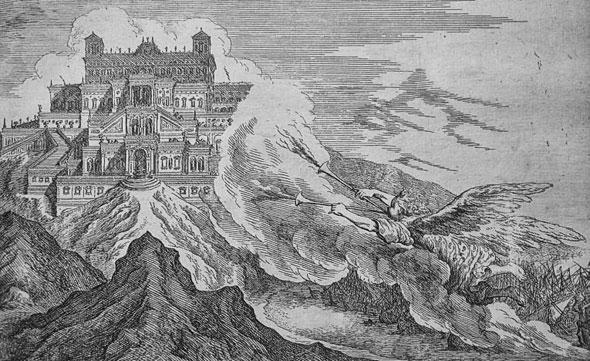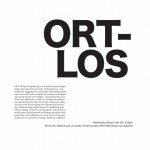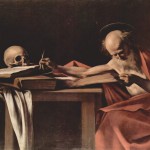House of Fame
La casa de la Fama
“The courts are fill’d with a tumultuous din
Of crowds, or issuing forth, or entering in;
Things never heard, some mingle truth with lies;
The troubled air with empty sounds they beat,
Intent to hear, and eager to repeat;
Error sits brooding there, with added train
Of vain credulity, and joys as vain:
Suspicion, with sedition join’d, are near,
And rumours raised, and murmurs mix’d,
and panic fear.” Ovid on House of Fama in Metamorphoses[1]
The Borromean rings[2] consist of three circles which are linked in such a manner that removing any ring results in two unlinked rings. The Borromean rings have been used in different contexts to indicate strength and unity, e.g. in religion or art. In particular, some have used the design to symbolize the Trinity. The psychoanalyst Jacques Lacan[3] famously found inspiration in the Borromean rings as a model for his topology of human subjectivity, with each ring representing a fundamental Lacanian component of reality (the “real”, the “imaginary”, and the “symbolic”). Later on Lacan’s concept of desire became central for his theories. For the aim of taking cure it is necessary to lead the analysands to uncover the truth about their desire, but this is only possible if this particular desire is articulated, or spoken about[4]. Lacan said: “It is only once it is formulated, named in the presence of the other, that desire appears in the full sense of the term.[5]” He also stated that it is important for the subject to bring desire into existence.
Standard diagram of the Borromean rings by Wikipedia
I have always tried to understand the world I am living in holistically with all its aspects – the world of information overflow and the world of infinite possibilities. A world which as a linked universe does not rely on random networks, but on huge amount of interlinked data which is sometimes just too complex for us to cope with it or to process it. Therefore, it is important, more then ever, not only to understand network workings and to describe network topologies, but also to develop novel tools and instruments in order to proactively deal with these networks. In other words, it is crucial to develop useful applications that will help us to make progress in the future within creative, connected, collaborative, and trans-disciplinary environments. The trans-disciplinary collaboration is important because of the huge amount of information we are confronted with which by exceeding our biological capacities as a single unit make any known scientific method which has been used until now obsolete.
Throughout history, architecture, more than any other discipline, has been defined by many dependencies on the cultural and technological progress of our civilization. If we do not understand architecture simply as building technology, architecture interferes with all aspects of human existence be it of political, social, cultural, philosophical, or technological, etc., nature. There is no other discipline which provokes discussion on the overall view of human living, in which anything is connected to everything. Indeed the three rings of Lacanian thinking are interwoven into architectural thinking since today’s unity of the real, the virtual, and the metaphorical exists only parallel and simultaneous. However, it has been always of my interest to ask what is beyond that. This “other” is not the same “das Andere” as defined by Freud, something we do not recognize but it is conceived by our sub-consciousness. It goes beyond our cognitive knowledge and it is something we cannot possibly know. It is a momentum when constructivism shifts to connectivism. In order to answer the questions: How do we gain knowledge from this endless sea of information? And when does pattern recognition make really sense? I have tried to define a new kind of thinking which I call “Architecture of the Networks” – a theory foundation for my studio Ortlos. Those ideas do not only consider the design of computer networks, but it outlines the structure of collaborative, creative processes within computer networks and delivers strategies which are useful in order to deal with these.
Johann Wilhelm Baur, Edition 1709, Ovid, Met. XII, 46-45
In Metamorphoses Ovid talks[6] about the house of the goddess Fama[7] as a kind of ortlos space. It is a space without place, or more likely an Infospace, as being a place where all the information of the universe can be perceived as “undulating” sound by having an access to information about everything that exists.
“There is a place at the centre of the World, between the zones of earth, sea, and sky, at the boundary of the three worlds. From here, whatever exists is seen, however far away, and every voice reaches listening ears. Fama lives there, choosing a house for herself on a high mountain summit, adding innumerable entrances, a thousand openings, and no doors to bar the threshold. It is open night and day: and is all of sounding bronze. All rustles with noise, echoes voices, and repeats what is heard. There is no peace within: no silence anywhere. Yet there is no clamour, only the subdued murmur of voices, like the waves of the sea, if you hear them far off, or like the sound of distant thunder when Jupiter makes the dark clouds rumble.[8]
Fama, the goddess of rumor, never sleeps and she hears everything that is spoken in the world, simultaneously, in an infinite sound of voices. From this noise, she filters out individual voices and directs them to ones ears, for which the voice was not determined.[9]
“Crowds fill the hallways: a fickle populace comes and goes, and, mingling truth randomly with fiction, a thousand rumors wander, and confused words circulate. Of these, some fill idle ears with chatter, others carry tales, and the author adds something new to what is heard. Here is Credulity, here is rash Error, empty Delight, and alarming Fear, sudden Sedition, and Murmurings of doubtful origin. Fama herself sees everything that happens in the heavens, throughout the ocean, and on land, and inquires about everything on earth.”
Illustration from the book by Geoffrey Chaucer “The House of Fame”. It is over 2,000 lines long in three books and takes the form of a dream vision. Upon falling asleep the poet finds himself in a glass temple adorned with images of the famous and their deeds.
The Infospace is a central element of “Architecture of the Networks”. It is a space which goes beyond the definition of objects through their formal or functional descriptions. It is a space which takes in account not what things mean or what they look like, but only what they perform in terms of their relationships. Of course, for a foreigner or outsider who enters the House of Fama, to conceive overall information as a sound means to only hear a non-understandable noise. It is only noise, because one has no possibilities or tools to decode and decipher the information.
Inigo Jones – drawing for “House of Fame” set
Umberto Eco claims in his book “Opera aperta”[10], that open artwork is an abstract hypothetical model, for which it is not much of importance how the problems have been solved, but rather how the problematic questions have been stated. He also distinguishes between Meaning and Information – information as a possibility to inform, as a virtually possible structure. As an instrument to apply his theory he uses the book “Finnegan Wake” by James Joyce. He argues that this masterpiece of modern literature is unreadable just because it can be read in so many ways, just like the Universe. It is clear to him that the reader does not have to understand every sentence or word he/she is reading, since the strength of this text is in its permanent ambiguity and mixture of many possible meanings, which are free to be chosen, but from a non-predefined choice, or are filter-dominated. In Joyce’s work there is no hierarchy of values, but constant juxtaposition. The book does not end, since it did not start in any particular way; it does not tell the story it is a story for itself.
Although I would agree to most of Eco’s arguments, there are still some moments, which are radically different at the dawn of the 21st century. First, the creative praxis (also the artistic one) is less and less expression of a single person or of an artistic collective. It is more an outcome of “connected intelligence”. Second, unreadability or information noise (according to Ovid) and endless possibilities of interpretations are only interesting on the representational level, but not on an interactive, engaging and participating level. In my opinion the “openness” of creative work is only interesting if somebody is able to do something with it and to relate to it; in other words if it is possible to evaluate what the doing does. The geniality of “Finnegans Wake” is not debatable, but it is still captured within its own framework of specific language (in this particular case English). With the emergence of Web 2.0 technologies and the development which will come after it, it has become clear that not a technological revolution is the driving engine behind it, but rather the social, world-wide connectivity of creative people. This, of course, produces even more “noise”. Therefore, it is of enormous importance to develop strategies and tools to deal with this new, enormous quantities of information in order to even better grasp new relational networks. The House of Fama is a pledge for even more openness and transparency, where tools are offered to decode the most complex knowledge (without decoder just noise) and make use of it.
[1] Ovid, Metamorphoses – Book XII, trans. John Dryden, et al (Harvard: Harper & brothers, 1836), 63.
[2] Site devoted to the Borromean Rings: http://www.liv.ac.uk/~spmr02/rings/index.html (accessed March 1, 2009)
[3] Jacques Lacan, The Seminar XI, The Four Fundamental Concepts of Psychoanalysis, ed. by Jacques-Alain Miller, transl. by Alan Sheridan (New York: W.W. Norton & Co., 1977).
[4] Bruce Fink, The Lacanian Subject: Between Language and Jouissance (Princeton University Press, 1996)
[5] Jacques Lacan, The Seminar of Jacques Lacan: Book I: Freud’s Papers on Technique 1953-1954 (W. W. Norton & Company, 1991)
[6] Ovid, Metamorphoses – Book XII
[7] Pheme was the goddess or spirit (daemon) of rumor, report and gossip. She was also, by extension, the dual spirit of fame and good repute in a positive sense, and infamy and scandal in the bad. In Greek mythology, Pheme (in Latin Fama) was the personification of fame and renown, her favor being notability, her wrath being scandalous rumors. Pheme was said to have pried into the affairs of mortals and gods, then repeated what she learned, starting off at first with just a dull whisper, but repeating it louder each time, until everyone knew. In art, she was usually depicted with wings and a trumpet.
[8] Ovid, Metamorphoses – Book XII 39-63 ff
[9] Ibid.
[10] Umberto Eco, Das offene Kunstwerk (Frankfurt am Main: Suhrkamp, 1998)















Comments
The title image for this story is a photo of Beat Furrer’s “Fama” opera. Article, in German, about this piece can be read here: http://www.zeit.de/2007/48/D-Musikklassiker
The German translation of Ovid’s Metamorphoses Book 12 mentioning the House of Fama (39-63) can be found here: http://www.textlog.de/35375.html or in a slightly different translation here: http://www.gottwein.de/Lat/ov/met12de.php
You must be logged in to post a comment.